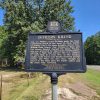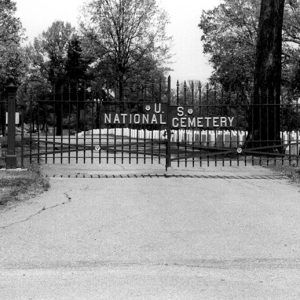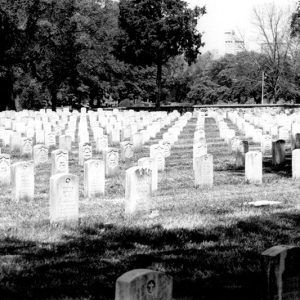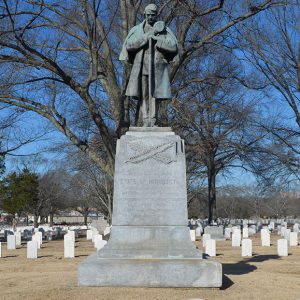calsfoundation@cals.org
Little Rock National Cemetery
Little Rock National Cemetery is the largest national cemetery in Arkansas and the only one closed to new interments. It is unknown when the first interment took place, or who it was, because the cemetery was part of the city cemetery at the time. The last active-duty burial was a man from Pine Bluff (Jefferson County) killed at the Pentagon on September 11, 2001. The cemetery was added to the National Register of Historic Places on December 20, 1996.
In 1866, the land that is now the cemetery was outside the city limits of Little Rock (Pulaski County) and served as a Union encampment for the troops who continued to occupy the city. In September 1866, the first 9.1 acres were purchased by the government from the new city cemetery to be used for military interments. Another 3.2 acres were added in April 1868, and on April 9 of that year, the cemetery was designated as Little Rock National Cemetery, its specific purpose being the interment of the remains of Union soldiers in Arkansas. That same year, the remains of 1,482 individuals were removed from different battlefields in the area and reinterred at the cemetery.
In 1869, the cemetery was enclosed by a fieldstone wall three feet high, and the first superintendent’s lodge was built. The lodge was a simple three-room brick building. In 1908, the lodge was replaced by a two-story, six-room building; in the 1930s, a sunroom and sleeping porch were added. In 1916, the Minnesota Monument was dedicated to honor the soldiers from Minnesota who had died in the Civil War and were buried in southern states. Parts of the rock wall were renovated to wrought iron in 1921 and 1929.
In 1884, the eleven-acre Confederate Cemetery was established next to the Little Rock National Cemetery. A monument, known as the Confederate Monument, was placed in the cemetery by trustees of Mount Holly Cemetery that year. Within the cemetery is also a fourteen-and-a-half-foot brick and cement rostrum with asphalt shingle roofing. It is not known exactly when it was constructed, but it was built by the Memorial Chapter of the United Daughters of the Confederacy, and the plaque is dated 1907. The remains of 640 Confederate soldiers were moved from Mount Holly Cemetery to the Confederate Cemetery. This cemetery became part of the Little Rock National Cemetery in 1913 when the Secretary of War accepted the deed from the City of Little Rock. The deed came with the stipulation that only Confederate veterans would be buried in the new section. In 1938, the restriction was dropped, and the cemetery became the Confederate section of the National Cemetery.
In 1990, five acres of land adjacent to the National Cemetery were donated to the cemetery by the National Expansion Corp., which had purchased the land from the Oakland Fraternal Cemetery. In 1996, a brick administration building with public restrooms and a committal service shelter were added. That same year, at a little over thirty-one acres, the Little Rock National Cemetery was added to the National Register of Historic Places. The last addition of land came in November 1999, when the City of Little Rock donated one acre. The Little Rock National Cemetery is not accepting new burials, with the exception of spouses or dependents being interred in an existing grave.
Two of the most notable people buried in the Little Rock National Cemetery are Simon A. Haley and Maurice L. Britt. Haley was a World War I veteran and the father of Alex Haley, the author of Roots. Britt served in World War II in the U.S. Army. He was a Medal of Honor recipient and served as lieutenant governor under Winthrop Rockefeller.
For additional information:
“Little Rock National Cemetery.” National Register of Historic Places nomination form. On file at Arkansas Historic Preservation Program, Little Rock, Arkansas.
Little Rock National Cemetery. U.S. Department of Veterans Affairs. http://www.cem.va.gov/cems/nchp/littlerock.asp (accessed February 6, 2024).
Silva, Rachel. “‘Their Deeds of Valor Live Forever’: The Little Rock National Cemetery, the Minnesota Monument, and the Little Rock Confederate Memorial.” Pulaski County Historical Review 59 (Summer 2011): 64–70.
Maranda Leeper
Waldron, Arkansas
 Civil War Markers and Memorials
Civil War Markers and Memorials Fayetteville National Cemetery
Fayetteville National Cemetery Fort Smith National Cemetery
Fort Smith National Cemetery Historic Preservation
Historic Preservation Little Rock National Cemetery
Little Rock National Cemetery  Little Rock National Cemetery
Little Rock National Cemetery  Minnesota Monument
Minnesota Monument  Wreaths Across America
Wreaths Across America 



Comments
No comments on this entry yet.